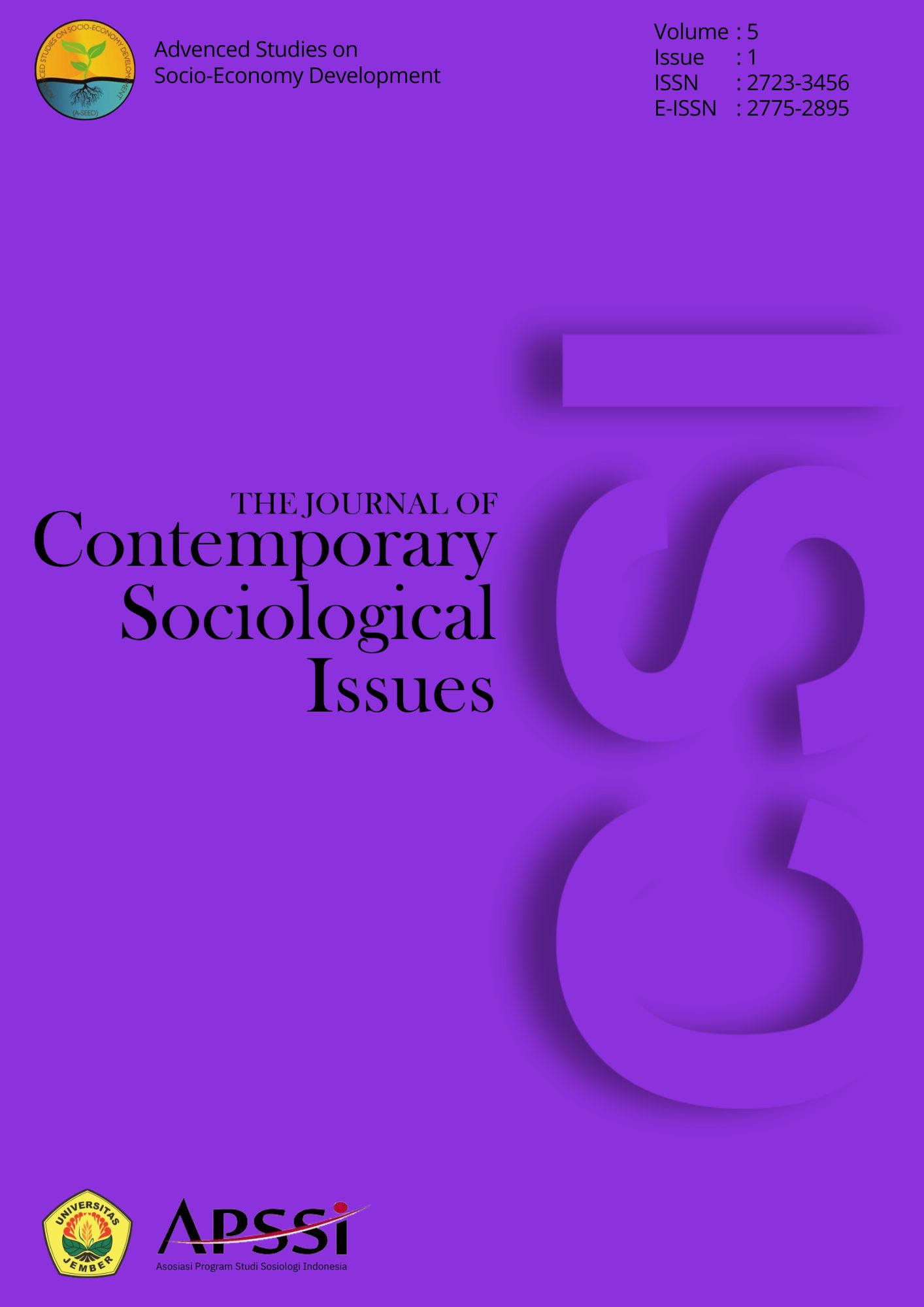Economic Drivers of Climate Migrant Settlement
Insights from ASEAN
DOI:
https://doi.org/10.19184/csi.v5i1.53464Keywords:
labour migrants, climate change, ASEAN, OECDAbstract
Migration patterns among ASEAN Member States (AMS) are diverse and complex, with nations like Brunei Darussalam, Malaysia, Singapore, and Thailand serving as net immigration countries. Conversely, Indonesia, the Philippines, and Vietnam are among the world’s largest emigration nations. Most migration within AMS is temporary and primarily consists of low-skilled workers, while many skilled workers from the region seek permanent migration opportunities in OECD countries. Economic factors serve as the primary drivers of migration; however, these are often intertwined with environmental, social, and economic influences. By examining the intersection of economic motivations and environmental pressures, this research focuses on economically driven migration (labor migration) in the context of economically driven climate migration. The study aims to understand climate-induced migration in ASEAN and investigates the role of OECD countries, which have become key destinations for ASEAN migrants. The research explores how migration patterns are affected by climate change's economic and environmental challenges and how these pressures shape migration flows within and beyond the region. Lastly, the research analyzes how ASEAN countries have recognized and responded to the economic challenges related to climate-induced migration, particularly amid rapid regional growth. Moreover, this article argues that the current migration frameworks in these countries of origin might require improvement, mainly to protect climate migrants better and enhance the understanding of ASEAN’s stance on this issue. Ultimately, this research promotes strategies for managing climate-induced migration within ASEAN and in collaboration with OECD countries, contributing to a global dialogue on climate migration.
Keywords: climate migration, labour migration, Southeast Asia, ASEAN, OECD
Downloads
References
Abrigo, MRM et al., “Greening the Philippine Employment Projections Model: New Estimates and Policy Options” (2021) Philippine Institute for Development Studies Discussion Paper Series 26.
Aburn, A & Wesselbaum, D, “Gone with the Wind: International Migration” (2019) 178 Global and Planetary Change 96.
Acharya, A, “The Myth of ASEAN Centrality” (2017) 39 Contemporary Southeast Asia 273.
Adams, H & Adger, WN, “Changing Places: Migration and Adaptation to Climate Change” in Linda Sygna, Karen O’Brien & Johanna Wolf, eds, The Changing Environment for Human Security: New Agendas for Research, Policy, and Action (Routledge, 2012).
ADB, “ADBI-OECD-ILO Roundtable on Labour Migration in Asia: Maximizing the Impact of Labour Migration on Development,” (14 September 2024) online: https://www.adb.org/news/events/adbi-oecd-ilo-roundtable-on-labor-migration-in-asia-maximizing-the-impact-of-labor-migration-on-development.
ADBI, OECD & ILO, Labour Migration in Asia: Impacts of the COVID-19 Crisis and the Post-Pandemic Future (ILO, 2021).
Ahmed, SA et al, “Climate Volatility and Vulnerability in Tanzania” (2011) 21 Global Environmental Change 46.
Araja, RN, Cayetano: Migrant Workers Act to ensure ‘ethical recruitment’, (Manila Standard, 9 January 2022), online: https://manilastandard.net/news/314031861/cayetano-migrant-workers-act-to-ensure-ethical-recruitment.html
ASEAN Secretariat, ASEAN Migration Outlook 2.0 (ASEAN, 2024).
———, ASEAN State of Climate Change Report: Current status and outlook of the ASEAN region. Toward the ASEAN climate vision 2050 (ASEAN, 2021).
ASEAN, “ASEAN Addresses Skills Development, Labour Market Needs and Just Transition” (24 April 2024), online: https://asean.org/asean-addresses-skills-development-labour-market-needs-and-just-transition/.
Asis, RP & Maningat, CL, “The ‘ASEAN Way’ in Migration Governance” in Heaven Crawley & Joseph Kofi Teye, eds, The Palgrave Handbook of South–South Migration and Inequality (Springer International Publishing, 2024).
Batalova, J, Shymonyak A & Sugiyarto G, Firing Up Regional Brain Networks: The Promise of Brain Circulation in the ASEAN Economic Community (Asian Development Bank, 2017).
Black, R et al, “The Effect of Environmental Change on Human Migration” (2011) 21 Global Environmental Change 3.
Boutkhil, G, The Effects of Climate Change on the Economic Growth of ASEAN Countries (International Studies Association, 2017), online: http://web.isanet.org/Web/Conferences/HKU2017-s/Archive/05d22192-b7f5-43cc-af17-6d2e1760b191.pdf
Bui, TH, “Một số giải pháp chủ yếu ứng phó với tác động của biến đổi khí hậu trong lĩnh vực lao động và xã hội (Some Main Solutions to Respond to the Impacts of Climate Change in the Field of Labour and Society)” (2013) 34 ILSSA 1.
Castles, S, “Understanding Global Migration: A Social Transformation Perspective” (2010) 36 Journal of Ethnic and Migration Studies 1565.
Chimni, BS, “Asian Civilizations and International Law: Some Reflections” (2011) 1 Asian Journal of International Law 39.
Corthay, E, “The ASEAN Doctrine of Non-Interference in Light of the Fundamental Principle of Non-Intervention” (2016) 17 Asian-Pacific Law & Policy Journal 1.
Dong, WS et al, “The Impact of Climate Change on Coastal Erosion in Southeast Asia and the Compelling Need to Establish Robust Adaptation Strategies” (2024) 10 Heliyon 4.
Eckstein, D, Kunzel, V & Shafer, L, Global Climate Risk Index 2021: Who Suffers Most from Extreme Weather Events? Weather-Related Loss Events in 2019 and 2000-2019 (Germanwatch, 2021).
Fisher, B et al, “Defining and Classifying Ecosystems Services for Decision-Making” (2009) 68 Ecological Economics 643.
Guadagno, L, Integrating migrants in emergency preparedness, response and recovery in their host countries: Training manual (IOM, 2016).
Harris, JR & Todaro MP, “Migration, Unemployment and Development: A Two-Sector Analysis” (1970) 60 American Economic Review 126.
Hertel, TW, Burke MB & Lobell DB, “The Poverty Implications of Climate-Induced Crop Yield Changes by 2030” (2010) 20 Global Environmental Change 577.
Hugo, G, “The Changing Dynamics of ASEAN International Migration” (2014) 51 Malaysian Journal of Economic Studies.
Hugo, G, Migration in the Asia-Pacific Region (GCIM, 2005).
ILO & ASEAN, Regional Study of Green Jobs Policy Readiness in ASEAN – March 2021 Highlights (ILO, 2021).
ILO, ASEAN Association of South-East Asian Nations: Employment and Environmental Sustainability Fact Sheets (ILO, 2019).
———, ASEAN: The Employment–Environment–Climate Nexus: The Employment Environmental Sustainability Factsheet (ILO, 2022).
———, Employment effects of green policies in the Philippines - Summary for Policymakers (ILO, 2019).
———, ILO Global Estimates of Migrant Workers and Migrant Domestic Workers: Results and Methodology (ILO, 2015).
———, Regional Study on Green Jobs Policy Readiness in ASEAN (ILO, 2021).
———, What Is a Green Job? (13 April 2016), online: https://www.ilo.org/resource/article/what-green-job.
———, World Employment and Social Outlook: Greening with Jobs (ILO, 2018).
IOM, Climate Change and Migration in Vulnerable Countries: A Snapshot of Least Developed Countries, Landlocked Developing Countries, and Small Island Developing States (IOM, 2017).
———, Labour Migration from Colombo Process Countries: Good Practices, Challenges and Ways Forward (IOM, 2015).
———, Labour Migration in Asia: What Does the Future Hold? (IOM, 2023).
Jurje, F & Lavenex, S, “Mobility Norms in Free Trade Agreements: Migration Governance in Asia between Regional Integration and Free Trade” (2018) 17(1) European Journal of East Asian Studies 83.
Kikkawa, A & Suan, EB, “Trends and Patterns in Intra-ASEAN Migration” in Elisabetta Gentile, ed, Skilled Labor Mobility and Migration (Cheltenham, UK: Edward Elgar Publishing, 2019).
Kwan, SC & McCoy, D, “Climate Displacement & Migration in South East Asia” (OCHA – ReliefWeb Blog, 28 February 2023), online: https://reliefweb.int/report/viet-nam/climate-displacement-migration-south-east-asia.
Lilleør, HB & Broeck KVD, “Economic Drivers of Migration and Climate Change in LDCs” (2011) 21 Global Environmental Change 7.
Marthin, A & Budiman, L, “The Discourse of Climate Migration: Unravelling the Politics of ASEAN’s Environmental Policies” (2020) 26 Pacific Journalism Review (2) 35.
Mayer, B, “Environmental Migration: Prospects for Regional Governance in Asia-Pacific Region” (2013) 16(1) Asia-Pacific Journal of Environmental Law 93.
McAdam, M, COVID-19 Impacts on the Labour Migration and Mobility of Young Women and Girls in South-East Asia and the Pacific (IOM, 2020).
Minehan, S & Wesselbaum D, “Do Climate Change Expectations Drive Migration? Evidence from Migration Flows towards OECD Countries” (2023) 227 Global and Planetary Change 9.
Nishimura, L, “‘Climate Change Migrants’: Impediments to a Protection Framework and the Need to Incorporate Migration into Climate Change Adaptation Strategies” (2015) 27 International Journal of Refugee Law 107.
OECD & ADBI, Managing Migration to Support Inclusive and Sustainable Growth (Asian Development Bank Institute, 2013).
OECD, “International Programme for Action on Climate (IPAC),” (14 September 2024) online: https://www.oecd.org/en/about/programmes/international-programme-for-action-on-climate.html.
———, “Southeast Asia Regional Programme (12 Feb 2025), online: https://www.oecd.org/en/about/programmes/southeast-asia-regional-programme.html.
———, “Southeast Asia” (14 September 2024), online: https://www.oecd.org/en/regions/southeast-asia.html.
———,International Migration Outlook 2023 (OECD, 2023).
———, Labour Migration in Asia: Trends, Skills Certification and Seasonal Work (OECD, 2024).
———, The Climate Action Monitor 2023: Providing Information to Monitor Progress towards Net-Zero (OECD, 2023).
———, Towards Greener and More Inclusive Societies in Southeast Asia, Development Centre Studies, (OECD Publishing, 2024).
Orbeta, AJ, “Enhancing Labour Mobility in ASEAN: Focus on Lower-Skilled Workers” (2013) 17 PIDS Discussion Paper Series 1.
Overland, I et al, “Impact of Climate Change on ASEAN International Affairs: Risk and Opportunity Multiplier” (2017) Norwegian Institute of International Affairs & Myanmar Institute of International and Strategic Studies 1.
Pauver, B, Twigg J & Sagramola S, Migrants, refugees, asylum seekers: Inclusion in disaster preparedness and response (Europa & Council of Europe, 2016).
Pérez, BF, “Beyond The Shortcomings of International Law: A proposal for the legal protection of climate migrants” in Simon Behrman & Avidan Kent, Climate Refugees (Routledge, 2018).
Petcharamesree, S, “ASEAN and Its Approach to Forced Migration Issues” (2016) 20 The International Journal of Human Rights 173.
Quisumbing, A & McNiven, S, “Moving Forward, Looking Back: The Impact of Migration and Remittances on Assets, Consumption, and Credit Constraints in the Rural Philippines” (2010) 46 Journal of Development Studies 91.
Raymer, J, Guan, Q & Ha, JT, “Overcoming Data Limitations to Obtain Migration Flows for ASEAN Countries” (2019) 28 Asian and Pacific Migration Journal.
Roeser, F et al., Five Major Shifts since the Paris Agreement that Give Hope in a Just, Paris-compatible Transition: a look back (NewClimate Institute, 2023).
Seto, K, “Non-Environmental Drivers of Migration to Cities in Asian and African Mega-Deltas” (2011) 21 Global Environmental Change 94.
Sharpe, SA & Martinex-Fernandez, CM, “The Implications of Green Employment: Making a Just Transition in ASEAN” (2021) 13 Sustainability 7389.
Stark, O & Levhari, D, “On Migration and Risk in LDCs” (1982) 31 Economic Development and Cultural Change 191.
Tay, M, “Human Rights, Culture, and the Singapore Example” (1995) 41 McGill Law Journal 743
United Nations, “International Migration Report” ST/ESA/SER.A/346 (2013).
———, International Migrant Stock | Population Division (United Nations Department of Economic and Social Affairs, 14 September 2024), online: https://www.un.org/development/desa/pd/content/international-migrant-stock.
Yang, D & Choi, HJ, “Are Remittances Insurance? Evidence from Rainfall Shocks in the Philippines” (2007) 21 The World Bank Economic Review 219.
Downloads
Published
Issue
Section
License
Copyright (c) 2025 Khanh-Linh Ta, Thu-Ha Ly

This work is licensed under a Creative Commons Attribution-NonCommercial-ShareAlike 4.0 International License.








